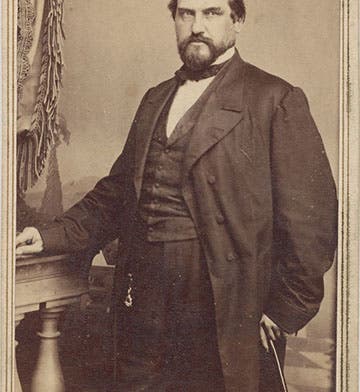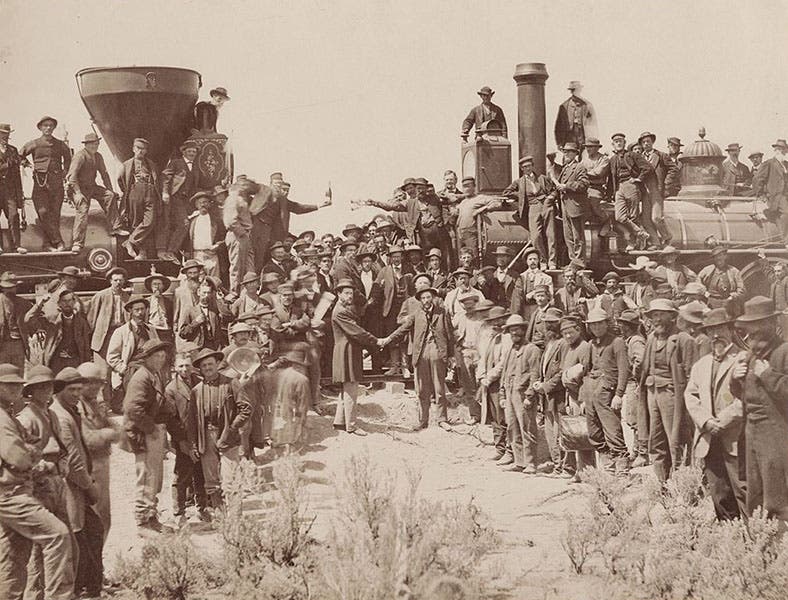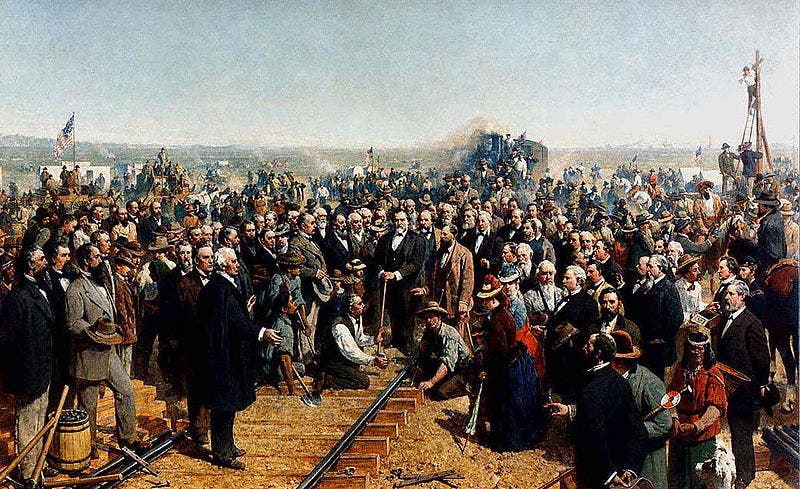Scientist of the Day - Leland Stanford
Leland Stanford, an American businessman, entrepreneur, and, according to some, a robber baron, was born Mar. 9, 1824. Stanford moved to California after the gold rush and rose to social prominence in Sacramento. In 1861, he was one of the "Big Four" Sacramento merchants who founded and financed the Central Pacific Railroad, on the prompting of Theodore Judah, a civil engineer who had a dream of a transcontinental railroad and who laid out the route through the Sierras. But Judah was forced out, and the Big Four carried out the project, with Stanford as President. On May 10, 1869, at Promontory Summit, Utah Territory, Stanford himself drove in the "golden spike" that united the Central Pacific line with that of the Union Pacific, which had been built west from Omaha. There is a map of the route of the Central Pacific in our post on Judah.
The event was recorded by photographer Andrew J. Russell, although the moment captured is after the spike was driven and the locomotives were advanced, cowcatcher to cowcatcher (second image, just above). Twelve years after the fact, artist Thomas Hill recreated Stanford’s big moment in a painting, which is today in the California State Railroad Museum (CSRM) in Sacramento, along with one of the two golden spikes. Stanford is the one in the center, holding the silver hammer (third image, below).
After completing the Central Pacific Railroad, Stanford turned to other vital matters, such as breeding racehorses, and in 1872, he engaged the services of pioneering motion photographer Eadweard Muybridge to resolve a bet: does a racehorse in full gallop ever have all four feet off the ground? We told this story in our post on Muybridge, where you may see a few of his stop-motion photographs. For this occasion, we present two images we did not show in our Muybridge post; the title page of The Horse in Motion (1882; fourth image, just below), with its prominent mention of Stanford’s role in the publication; and a detail of a heliotype with twenty frames of a galloping horse named Mohammed. In the detail, two frames clearly capture Mohammed with all his feet off the ground (fifth image, below).
There are two physical memorials of Stanford that are worth mentioning. The first is the locomotive Gov. Stanford, the first locomotive bought by the Central Pacific, which was delivered in 1863, and wore the number "1" on the front of its boiler. It is available for viewing at the CSRM, where it is much more handsome than the fake rock wall background that surrounds it. The locomotive’s name comes from the fact that Stanford was governor of California in 1862-63. The two-year term was mandated by law at the time.
The other Stanford memorial is Stanford University in Palo Alto, which Leland and his wife founded in 1891 in honor on their only son, Leland Jr., who died of typhoid fever at age 15. The university is not named for either of the parents, but for their son, and the school’s official name is Leland Stanford Junior University. The very first student to enroll at the university, it is traditionally said, was Herbert Hoover.
All three Stanfords are buried in a not-so-modest mausoleum, complete with sphinxes on guard, on the Stanford University grounds. You can see it here.
Dr. William B. Ashworth, Jr., Consultant for the History of Science, Linda Hall Library and Associate Professor emeritus, Department of History, University of Missouri-Kansas City. Comments or corrections are welcome; please direct to ashworthw@umkc.edu.











